Rhode Island is the smallest of all the 50 states. It’s less than 50 miles long and only about 40 miles wide. Even though it’s small it has one of the longest coastlines of any state with a huge 400 miles of ocean coastline. The geography of Rhode Island is mixed. The southeast is mostly sandy beaches, marshes, and lowlands because of the proximity to the ocean. But the rest of the state has vast forests, hills, and lakes.
Rhode Island isn’t a big state, so there aren’t a lot of native types of snakes that call Rhode Island home. The state’s geography supports 12 snake species and we’re talking about six of these slithering reptiles.
1. Northern Water Snake (Nerodia sipedon)
Northern water snakes are semi-aquatic, which means that they prefer being in or around water. These snakes live in the southeast area of Rhode Island in the lowland marshes and areas near the ocean. They also live in the north region of the state near some of the state’s bigger rivers and lakes. Northern water snakes can be light gray to dark gray, dark olive, or black and usually have dark red or red-orange blotches down the length of their body. They are very curious snakes and they may approach you in the water fishing or they may approach your boat. However, these harmless snakes won’t bother you if you don’t bother them — a quick splash will probably send it on its way.
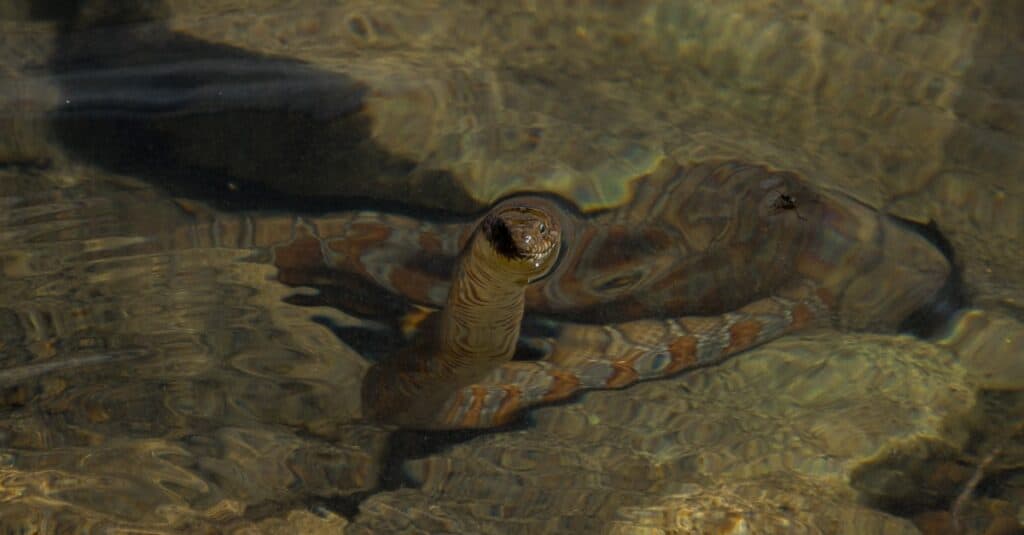
The northern water snake reaches up to 4.5 feet in length.
©iStock.com/manuellacoste
2. Eastern Ribbon Snake (Thamnophis sauritus)
Eastern ribbon snakes also like to be near the water however they tend to gravitate more toward rivers and lakes than the ocean areas. These snakes are almost always dark olive, dark gray, or dark brown and have three very thin yellow or white stripes running down the length of their bodies.
Ribbon snakes don’t get very big and most of them are under four feet long. But they are very thin and narrow. They can look like a ribbon curling when they move which is how they got their name. If you’re fishing near the shore of a pond or if you’re kayaking on a lake or river keep a sharp eye out for ribbon snakes. They won’t bite you, even if you surprise them. But they will sometimes put out a terrible smell if they are scared or feel threatened.

Look out for the ribbon snake when near water in Rhode Island — they don’t bite but emit a terrible smell when startled.
©Steve Bower/Shutterstock.com
3. Smooth Green Snake (Ophiodrys vernalis)
Smooth green snakes have a very distinctive bright spring green color that you can’t miss. In Rhode Island, smooth green snakes are primarily found around the coastal area. They love to hide near the edges of water but with their bright green coloring they are pretty easy to see. They’re small snakes. Most are only one to two feet long. You can sometimes see smooth green snakes in abandoned or undeveloped lots.
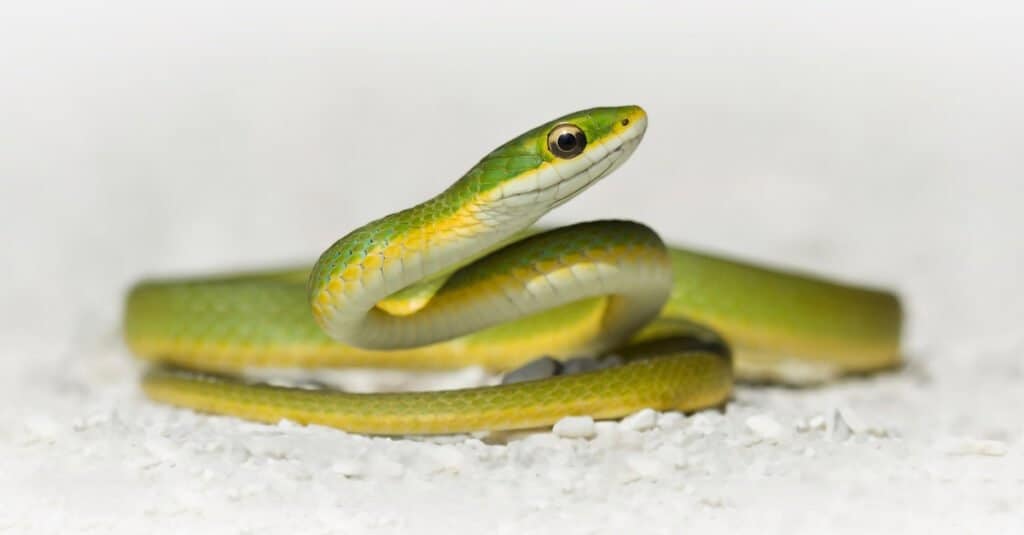
Smooth green snakes are primarily found along the coastal area of Rhode Island.
©Kristian Bell/Shutterstock.com
4. Northern Black Racer (Coluber constrictor)
If you see a big black snake it might look scary, but the northern black racer isn’t a scary snake at all. Northern black racer snakes are very long and some are a whopping six feet long — with their muscular build and bad attitude when cornered, they can be intimidating. But the black racer is not venomous and prefers to flee from people rather than attack. These snakes mainly live in forests and grasslands areas. If you surprise a black racer it may move its tail back and forth quickly imitating the rattle of a rattlesnake but it’s not a rattlesnake and it’s not venomous. A scared northern black racer may strike out, but these snakes move very quickly and if you stop for a minute and give it a chance to run away it’s most likely going to speed away from you as fast as it can.
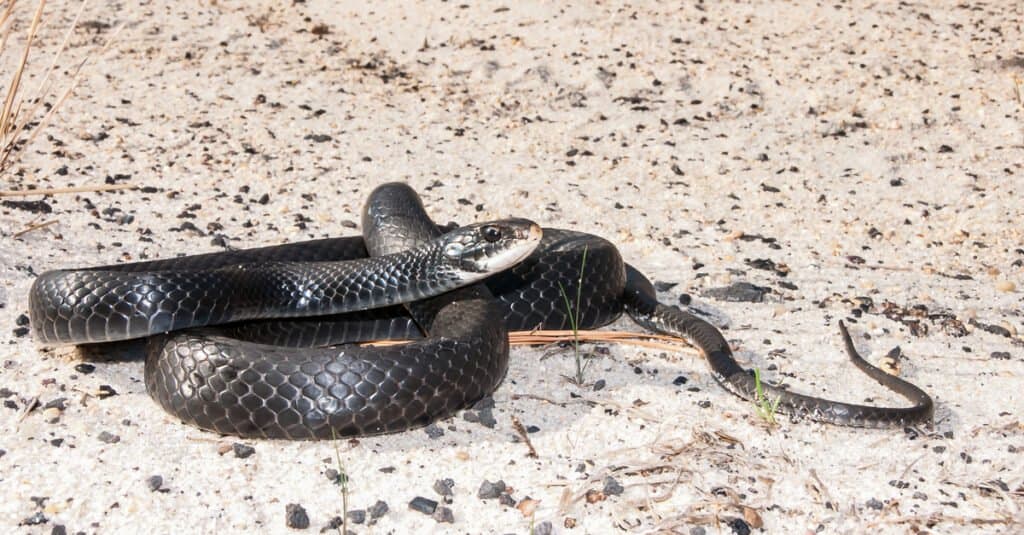
The black racer snake is long and sometimes intimidating but is non-venomous.
©Jay Ondreicka/Shutterstock.com
5. Eastern Milk Snake (Lampropeltis triangulum)
Most snakes avoid populated areas. But the eastern milk snake is most often found near man-made buildings like barns, sheds, garages, and outbuildings. Typically the eastern milk snake has a light colored body that’s tan or light brown and it has large red or reddish brown patches that run down the length of the body. The patches are outlined with black or dark brown. Most eastern milk snakes average about 30 inches in length but they can grow as large as 52 inches length. The markings on the eastern milk snake and light coloration can lead to people mistaking it for a copperhead rattlesnake. This crafty snake also will coil up and make a sound with its tail like a rattle when it’s threatened to make predators think it’s a rattlesnake. But there are no rattlesnakes in Rhode Island.
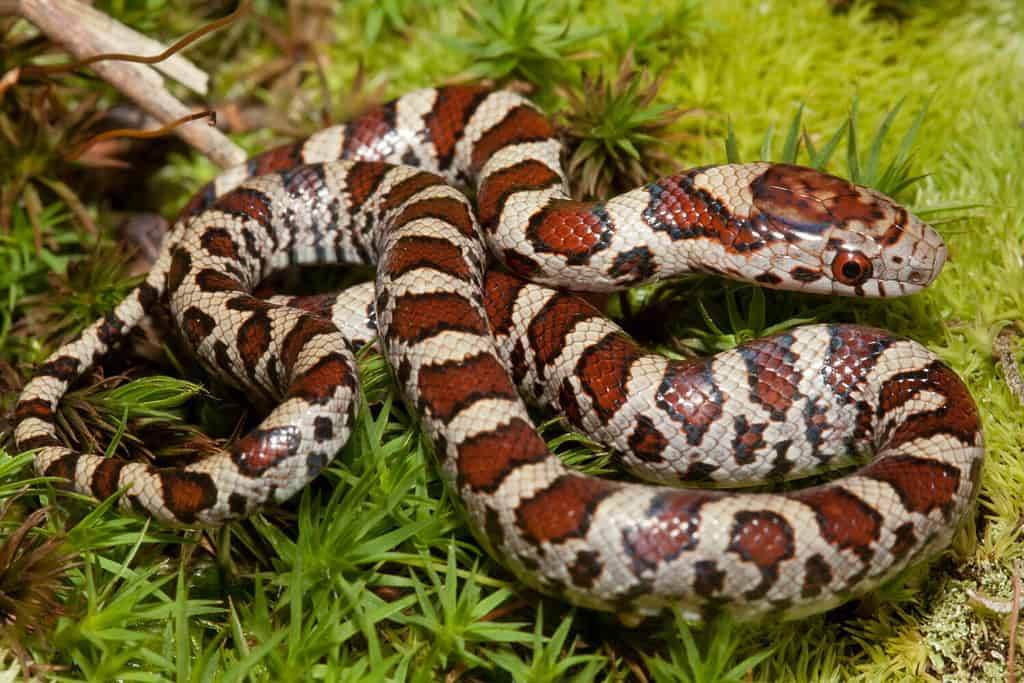
The milk snake’s markings lead people to mistake it for a copperhead rattlesnake.
©Nathan A Shepard/Shutterstock.com
6. Allegheny Rat Snake (Pantherophis allegheniensis)
The Allegheny rat snake is also called the Eastern rat snake. It’s the largest of all the snakes in Rhode Island and can grow to six feet long. Rat snakes are very beneficial to farmers. They eat the rodents and vermin that can damage crops, giving rise to its nickname “the Farmers’ Friend.” In Rhode Island you will only find these snakes in the very furthest southwestern portion of the state, near Hopkinton and Exeter.
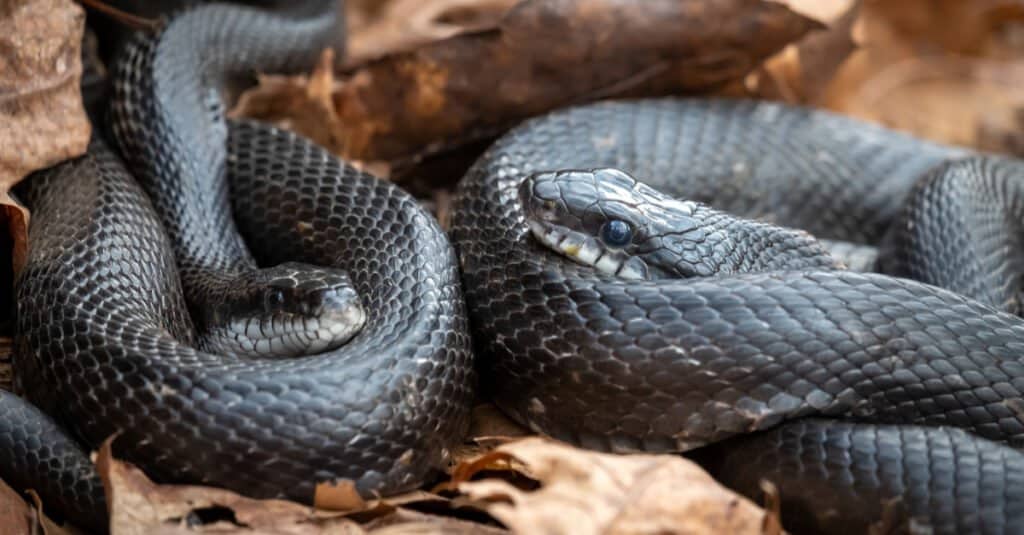
Eastern rat snakes are beneficial to farmers as they eat crop-damaging animals such as rodents and vermin.
©samray/Shutterstock.com
Summary of Common Snakes in Rhode Island

Here’s a recap of Rhode Island’s six most commonly found snake species that we took a close look at.
| Number | Snake | Habitat |
|---|---|---|
| 1 | Northern Water Snake | Southeast Rhode Island in lowland marshes and areas near the ocean; north region near bigger rivers and lakes |
| 2 | Eastern Ribbon Snake | Rivers and lakes |
| 3 | Smooth Green Snake | Primarily found around coastal area; also can be seen in cities around abandoned or undeveloped lots |
| 4 | Northern Black Racer | Mainly live in forests and grasslands |
| 5 | Eastern Milk Snake | Near man-made buildings such as barns, sheds, garages, and outbuildings |
| 6 | Allegheny Rat Snake | In very furthest southwestern portion of the state, near Hopkinton and Exeter |
Venomous Snakes in Rhode Island
Rhode Island is one of the very few states in the United States that has no type of venomous snakes. So if you’re afraid of venomous snakes but you love to hike or spend time outdoors Rhode Island is the place for you. At one point there were timber rattlesnakes, which are venomous snakes, in Rhode Island. But there haven’t been any active sightings of any timber rattlesnakes in Rhode Island for more than 30 years.
There isn’t any danger of finding a venomous snake in Rhode Island. But any snake will bite or become aggressive if it’s provoked. Even though the snakes in Rhode Island are not venomous you should still be wary of them and treat them with respect. Don’t attack, try to trap, or try to handle any wild snake. The best thing to do if you see a snake when you’re outdoors is leave it alone. Most of the time snakes will leave you alone if you leave them alone.
A Complete List of Snakes in Rhode Island
There are only 12 types of native snakes in Rhode Island. So you may not even see any snakes during your time outdoors. But if you do see snakes when you’re out in Rhode Island leave them alone. If you surprise a snake or come up on one suddenly just stop and wait a minute. The snake will probably just go away if you give it the chance. If it doesn’t move then you should leave so the snake can keep moving. The 12 different types of snakes that you might see in Rhode Island are:
| Number | Common Name | Scientific Name | Average Length |
|---|---|---|---|
| 1 | Allegheny Rat Snake | Pantheropis alleghaniensis | 3.5 – 7 ft. (1 – 2 m) |
| 2 | Northern Water Snake | Nerodia sipedon | 2 – 4.5 ft. (0.61-1.40 m) |
| 3 | Eastern Garter Snake | Thamnophis sirtalis sirtalis | 1.5 – 5.5 ft. (0.45 – 0.66 m) |
| 4 | Northern Brown Snake | Storeria dekayi | 6-13 in. (17 – 33 cm) |
| 5 | Eastern Ribbon Snake | Thamnophis sauritis | 16 – 28 in. (41 – 71 cm) |
| 6 | Smooth Green Snake | Opheodrys vernalis | 11 – 20 in. (30.3 – 51 cm) |
| 7 | Eastern Worm Snake | Carphophis amoenus amoenus | 7.5 – 11 in. (19 – 28 cm) |
| 8 | Northern Black Racer | Coluber constrictor constrictor | 3 – 5 ft. (0.90 – 1.52 m) |
| 9 | Eastern Hognose Snake | Heterodon platirhinos | 2 – 3 ft. (0.61 – 0.90 m) |
| 10 | Northern Ringneck Snake | Diadophis punctatus edwardsii | 10 – 15 in. (25.4 – 38 cm) |
| 11 | Eastern Milk Snake | Lampropettis triangulum | 2 – 3 ft. (0.61 – 0.90 m) |
| 12 | Northern Red-Bellied Snake | Storeria occipitomaculata occipitomaculata | 4 – 10 in. (10 – 25 cm) |
The photo featured at the top of this post is © iStock.com/sdbower
Discover the "Monster" Snake 5X Bigger than an Anaconda
Every day A-Z Animals sends out some of the most incredible facts in the world from our free newsletter. Want to discover the 10 most beautiful snakes in the world, a "snake island" where you're never more than 3 feet from danger, or a "monster" snake 5X larger than an anaconda? Then sign up right now and you'll start receiving our daily newsletter absolutely free.
FAQs (Frequently Asked Questions)
Are there venomous snakes in Rhode Island?
Rhode Island is one of the very few states in the United States that has no type of venomous snakes. At one point there were Timber Rattlesnakes, which are venomous snakes, in Rhode Island. But there haven’t been any active sightings of any Timber Rattlesnakes in Rhode Island for more than thirty years.
What are common snakes found in Rhode Island?
Some of the most common snakes found in Rhode island are: Alleghany Rat Snake, Northern Water Snake, Eastern Ribbon Snake, Smooth Green Snake, Northern Black Racer Snake and Eastern Milk Snake.
Thank you for reading! Have some feedback for us? Contact the AZ Animals editorial team.






